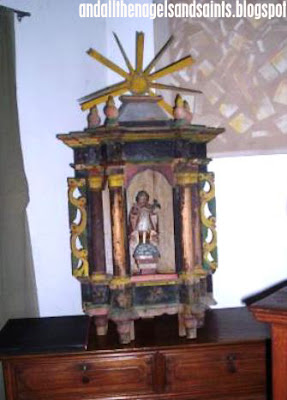FOLK SAGRADA FAMILIA, polychromed on a mortar-shaped base, 16 ". Provenance: Manila.
The Roman Catholic Church celebrates the Feast of the Holy Family on ration of the Holy Family Sunday, following Christmas. It was in the 17th century that the devotion began by the Canadian religious, Msgr. Francois de Lival who organized a local confraternity.
SAGRADA FAMILIA, antique ivories, restored and redressed, Raffy Lopez Workshop.
In 1893, Pope Leo XIII instituted the devotion in the liturgical calendar, on the Sunday within the Octave of the Epiphany, subsequently moved in 1969 to the Sunday within the octave of Christmas (that is, between Christmas and New Year).
SAGRADA FAMILIA, century-old folk santos, gessoe'd and polychromed. 16 ". From the Visayas. Offered at a Manila antique shop.
As a theme in Christian art, the “Sagrada Familia” showing Maria, Jesus with Jose, grew out of the Western version of the theme of Nativity, which was current in Europe from the 14th to the 17th c. Variations included depicting the Holy Family at work (St. Joseph performing carpentry work being aided by Jesus, with Mary doing domestic work like sewing); and the young Jesus walking in between His parents, with God the Father hovering above the trio.
SAGRADA FAMILIA, in the folk style. The short, squat bodies still retain their original paint. They stand on a square base with serrated edges and painted folksy floral motif.
Other popular representations include additional figures like Sta. Ana (St. Anne), San Juan Bautista (St. John the Baptist) and St. John’s mother, Elizabeth. The Holy Family as an art subject has been painted by practically all the great names in our art history, including Raphael, Michaelangelo, El Greco and Rembrandt. A sampling of folk santos representing the Sagrada Familia are featured on this page
SAGRADA FAMILIA. Brilliantly painted and primitively carved Holy Family santos.
Provenance: Cebu.
SAGRADA FAMILIA. Small, 8 inch. santos with faces almost rubbed off. Lightwood, on a base. Provenance: Cagayan.
SAGRADA FAMILIA. Carved by a more seasoned artisan. Traces of paint. Offered by a Manila antique shop.
SAGRADA FAMILIA. Carved lightwood santos, with much paint loss. Mary is surprisingly taller than Joseph which appears to be carved hastily, with minimum features. Offered by an antique shop in Pampanga.
SAGRADA FAMILIA IVORIES. Small santos representing the family, each with an ivory head and hands. The mannikin bodies still retain their tattered clothes embellished with gold thread embroidery. Personal Collection.
SAGRADA FAMILIA. A stunning Holy Family group made of ivory and dressed in gold-embroidered clothes. The santos, surmounted by the fihure of God The Father, are enshrined in a magnificent folk altar flanked with angels.
SAGRADA FAMILIA. Naive santo carvings of Jesus, Mary and Joseph on a mortar-shaped base, typical of many Visayan santos.





























































